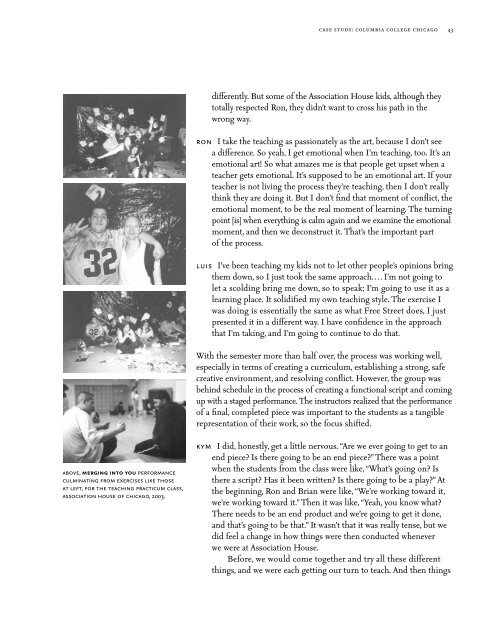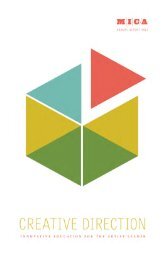art/vision/voice - Maryland Institute College of Art
art/vision/voice - Maryland Institute College of Art
art/vision/voice - Maryland Institute College of Art
You also want an ePaper? Increase the reach of your titles
YUMPU automatically turns print PDFs into web optimized ePapers that Google loves.
above, merging into you performance<br />
culminating from exercises like those<br />
at left, for the teaching practicum class,<br />
association house <strong>of</strong> chicago, 2003.<br />
case study: columbia college chicago 43<br />
differently. But some <strong>of</strong> the Association House kids, although they<br />
totally respected Ron, they didn’t want to cross his path in the<br />
wrong way.<br />
ron I take the teaching as passionately as the <strong>art</strong>, because I don’t see<br />
a difference. So yeah, I get emotional when I’m teaching, too. It’s an<br />
emotional <strong>art</strong>! So what amazes me is that people get upset when a<br />
teacher gets emotional. It’s supposed to be an emotional <strong>art</strong>. If your<br />
teacher is not living the process they’re teaching, then I don’t really<br />
think they are doing it. But I don’t find that moment <strong>of</strong> conflict, the<br />
emotional moment, to be the real moment <strong>of</strong> learning. The turning<br />
point [is] when everything is calm again and we examine the emotional<br />
moment, and then we deconstruct it. That’s the important p<strong>art</strong><br />
<strong>of</strong> the process.<br />
luis I’ve been teaching my kids not to let other people’s opinions bring<br />
them down, so I just took the same approach. . . . I’m not going to<br />
let a scolding bring me down, so to speak; I’m going to use it as a<br />
learning place. It solidified my own teaching style. The exercise I<br />
was doing is essentially the same as what Free Street does, I just<br />
presented it in a different way. I have confidence in the approach<br />
that I’m taking, and I’m going to continue to do that.<br />
With the semester more than half over, the process was working well,<br />
especially in terms <strong>of</strong> creating a curriculum, establishing a strong, safe<br />
creative environment, and resolving conflict. However, the group was<br />
behind schedule in the process <strong>of</strong> creating a functional script and coming<br />
up with a staged performance. The instructors realized that the performance<br />
<strong>of</strong> a final, completed piece was important to the students as a tangible<br />
representation <strong>of</strong> their work, so the focus shifted.<br />
kym I did, honestly, get a little nervous. “Are we ever going to get to an<br />
end piece? Is there going to be an end piece?” There was a point<br />
when the students from the class were like, “What’s going on? Is<br />
there a script? Has it been written? Is there going to be a play?” At<br />
the beginning, Ron and Brian were like, “We’re working toward it,<br />
we’re working toward it.” Then it was like, “Yeah, you know what?<br />
There needs to be an end product and we’re going to get it done,<br />
and that’s going to be that.” It wasn’t that it was really tense, but we<br />
did feel a change in how things were then conducted whenever<br />
we were at Association House.<br />
Before, we would come together and try all these different<br />
things, and we were each getting our turn to teach. And then things
















